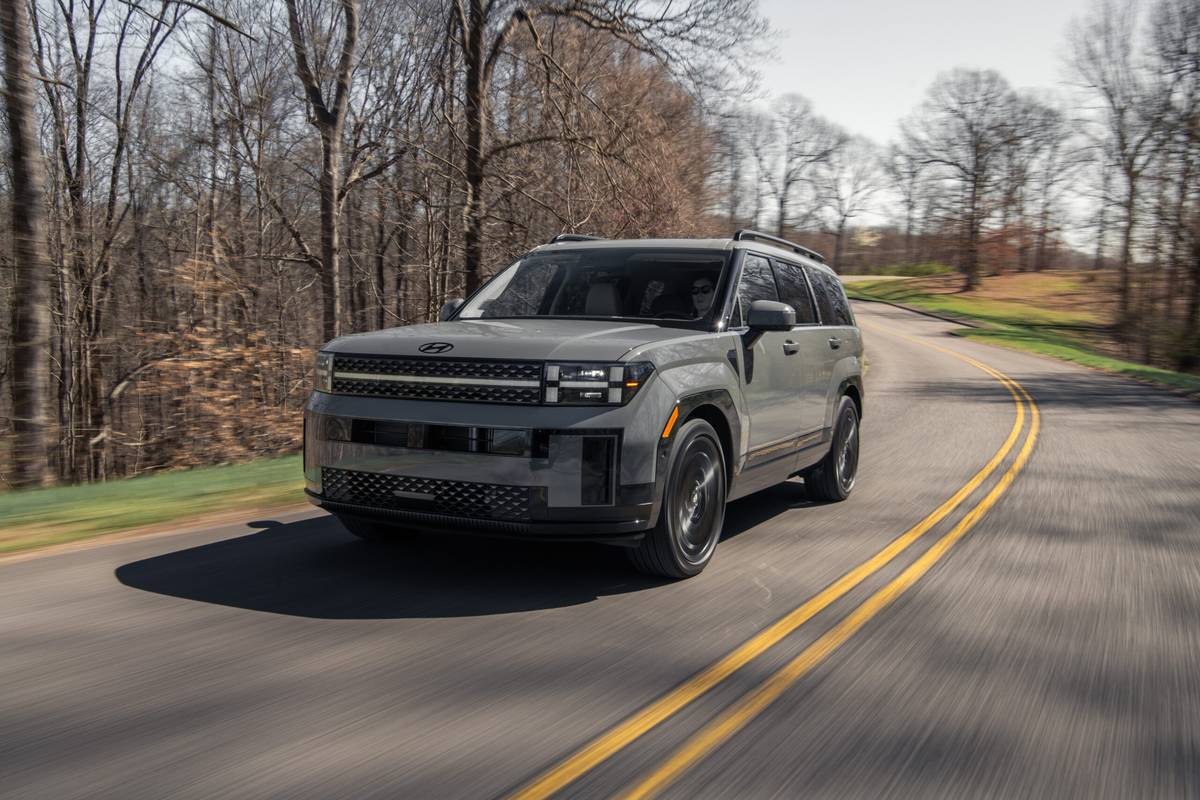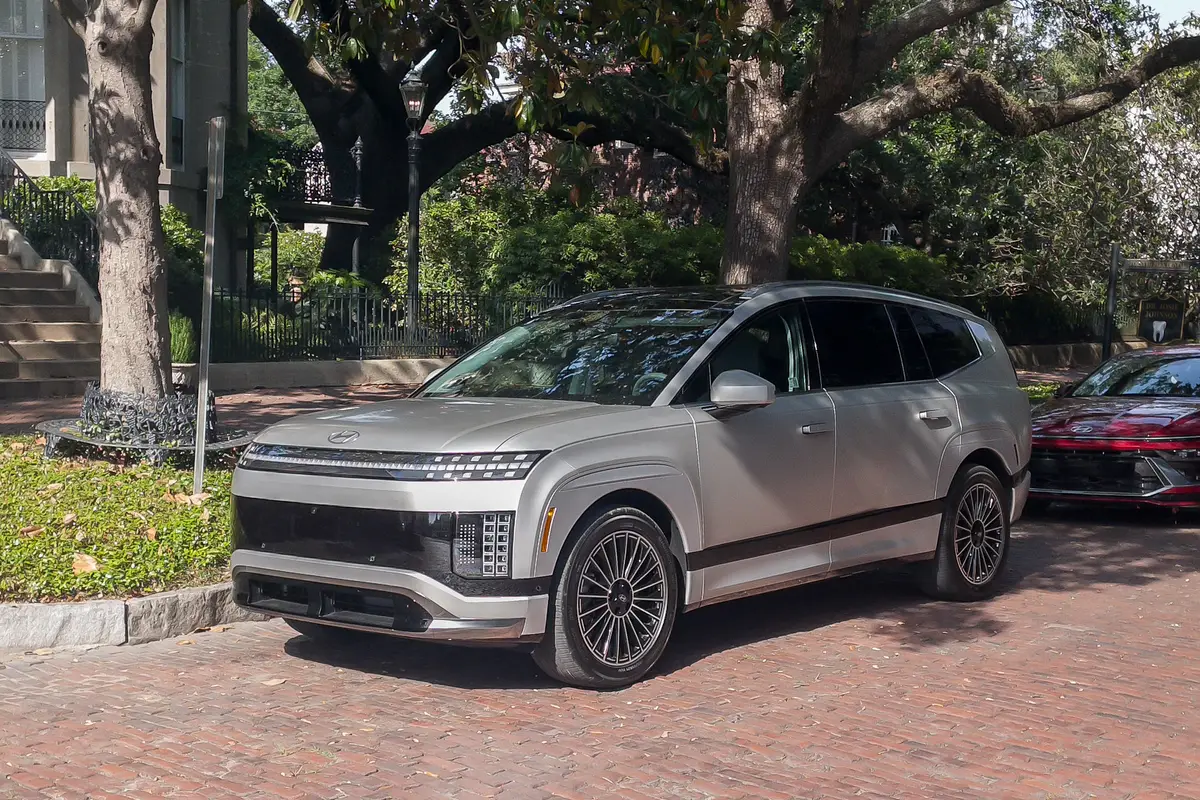Video: 2022 Hyundai Tucson: Review
By Cars.com Editors
December 9, 2021
Share
About the video
The redesigned 2022 Hyundai Tucson is a value-oriented compact SUV with promising refinement, but higher trim levels swap in cumbersome touch-sensitive controls — a deal breaker that might keep a well-optioned example off your list.
Transcript
(upbeat music) The redesigned 2022 Hyundai Tucson is a value-oriented compact SUV with promising refinement. But higher trim levels, swap and cumbersome touch sensitive controls, that's a major strike against any well option example of this SUV.
Though, lower trim levels still holds some potential. Now, the Tucson has a four-cylinder engine with front or all-wheel drive. There's also a Tucson Hybrid and a Tucson Plug-in hybrid, both of those pair a smaller turbocharged four-cylinder engine with an electric motor, and exclusively, all-wheel drive. Now, between those three variations of drivetrain, you've got nine trim levels. It'll set you back anywhere from around $26,500 all the way up to about $44,000 for a very well optioned example. We've had a chance to evaluate both a gas-only Tucson and a Tucson Hybrid, both pretty well-equipped examples. And we've even compared the gas-only one to five other popular compact SUVs, so you have a pretty good idea of how this SUV stacks up. We'll get to the merits of this interior in a minute, but first the elephant in the room has to be discussed. Higher trim levels of the new Tucson adopt touch sensitive dashboard controls instead of physical buttons and knobs. They're here for pretty much everything below the touch screen. There's volume keys here that are touch sensitive, tuning, climate, air conditioning, you name it, it's on this big touch panel. Now, we're seldom this dismissive of a car outright, but it bears noting that this isn't just us. Leading consumer studies also show that real owners just want things like a volume knob. Not sure why Hyundai took it away. Here's the good news though, lower trim levels of the Tucson actually do have physical controls here for the climate, yes, it's manual not automatic climate control. But again, real buttons and knobs, much easier to use. There's also a conventional lever style gear selector. You get up to higher trim levels, especially in the Tucson Hybrid, everything becomes capacitive touch. This is now becomes a push button gear selector, all more confusing and harder to use. And here's the other kicker, base models of the Tucson have an eight inch touchscreen with wireless Apple CarPlay, wireless Android Auto. You get up to higher trims, now it's a 10 and a quarter inch screen, so a bit bigger. But it's wired Apple CarPlay, wired Android Auto, that's a more conventional connection, certainly less convenient. The upgrade seem more like downgrades, honestly. So unless you're a glutton for irritation, you might want to avoid these versions entirely. All right, now that we got that out of the way, there's plenty of potential otherwise. Most controls, aside from that center stack, operate with precision and heft, and the cabin has an open kind of layered dashboard approach with attractive textures throughout. Certainly competitive with other compact SUVs. Now, similar to the rest of the class, though, you get to the rear seats and Hyundai does cheap out a little bit. But both rows are fairly roomy with a nice commanding perch from the driver's side and dual height adjusters. That, among other features, helped the Tucson earn very high marks from Cars.com reviewers for front seat comfort and features relative to the class. And back, easy access, LATCH anchors, and plentiful leg room. Fit even our bulky rear facing car seats, helping the Tucson pass Cars.com car seat check with flying colors. Now, headroom in both rows is adequate, not exceptional. Collar drivers might feel it a little bit pinched, especially if you get the panoramic moonroof. That's a feature in all the test cars we've had here for the Tucson. Without it, Hyundai says there's an additional half inch of rear headroom and a much needed two inches more front headroom. Now, in Cars.com's independent accounting of cargo space, we've observed pretty good numbers here in the Tucson. This is the non-hybrid again. About 21 and a half cubic feet behind the backseat, pretty good versus the Tucson's immediate competitors. The Tucson Hybrid has a tire inflator kit in place of this temporary spare under the load floor, that results in a reconfigured load floor with a little bit more space underneath, about 0.2 cubic feet by our observations. Now, we haven't tested the Tucson Plug-in Hybrid, but it does lose this dual level load floor. And by Hyundai's own specs, there's about 20% less volume in the Tucson Plug-in Hybrid versus the Tucson Hybrid. So if you've got to carry a lot of stuff, now you've been warned. Now, we can't attest to how the Tucson Plug-in Hybrid drives, but we've been impressed with the Tucson's regular hybrid and gas-only models. Ride quality isn't exactly a shining strength for a lot of rival compact SUVs, but Cars.com reviewers described the Tucson's ride as sophisticated, and even a class above. Body motion seems reasonably controlled with minimal bounciness after rapid elevation changes or recessed sewer covers. We noticed some lateral movement over mid corner bumps, but overall impact harshness is muted enough, even with the 19-inch wheels and low-profile tires on both our gas-only and hybrid test cars. Lower trim levels for the Tucson have 17-inch wheels, and higher profile tires, that might make the SUV ride even softer. Either way, another good thing, noise levels. Our reviewers said noise levels in the Tucson versus some of its immediate competitors, very, very good. This is a quiet overall SUV. Gasoline models employ an eight-speed automatic transmission whose tendency to upshift early enough, and can leave you wanting more power during low speed acceleration. Instead you're often a gear too high, and a thousand RPM too low. The transmission becomes a serviceable companion. Above that though, downshifting with minimal delay, if you need to accelerate at highway speeds. Pushed to higher RPM, the engine serves up adequate, if noisy power. Steering feedback is lackluster, but it improves notably with a driver selectable sport mode that dials back power assist. Body roll is limited throughout, but overall balance feels about as nose heavy as any front drive based compact SUV. The Tucson Hybrid improves on that balance with enough to eliminate most of the gas-only models chronic understeer. That's a noticeable result of its battery pack, adding much needed weight around the rear axle. As such, road holding improves enough to make the hybrid SUV a bit of fun to throw around. The hybrid drivetrain is, well, sometimes fun. It pairs a pint-sized turbo four-cylinder with a small electric motor, and the combination makes for swift linear power when both are in play. That's thanks to a conventional six-speed automatic transmission, not the continuously variable style you find in most hybrids. Unfortunately, those spurts are rare in daily driving, where the Tucson Hybrid minimizes engine power as much as possible. Under mostly electric power with a periodic dollop of engine, the Tucson Hybrid feels tentative, even gutless. If you let foot your way around town, or always driving sport mode, the drivetrain does show its stuff, but that's going to kill your gas mileage, which, last time I checked, was half the reason anyone buys a hybrid. Anyone shopping higher trim levels of the 2022 Tucson will have to make peace with those fussy touch controls, as well as parting with maybe more than $40,000. At that, we really think there are better choices elsewhere. Plenty of rival compact SUVs feature rich interiors with more intuitive physical controls. This ain't rocket science. Fortunately, lower trim levels of the Tucson offer the double benefit of added value, including Hyundai's excellent warranty and class leading free maintenance, with physical controls and better smartphone integration. Less is more here, folks. If any Tucson trims are worth considering, it's those.
Featured stories

By Patrick Masterson
July 2, 2025

By Drew Koenig
June 27, 2025

By Jared Gall
June 27, 2025
